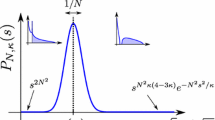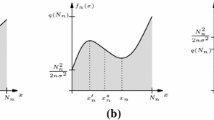Abstract
We consider space- and time-uniformd-dimensional random processes with linear local interaction, which we call harnesses and which may be used as discrete mathematical models of random interfaces. Their components are rea random variablesa ts , wheres ∈ Zd andt=0, 1, 2.,... At every time step two events occur: first, every component turns into a linear combination of itsN neighbors, and second, a symmetric random i.i.d. “noise”v is added to every component. For any σ ∈Z +d define Δσ a′ s as follows. If σ=(0,...,0), σ=(0,...,0), Δσ a t s =a t s . Then by induction,\(\Delta _{\sigma + e_1 } a_s^t = \Delta _\sigma a_{s + e_1 }^t - \Delta _\sigma a_s^t \) wheree i is thed-dimensional vector, whoseith component is one and other components are zeros. Denote |σ| the sum of components of σ. Call a real random variable ϕ symmetric if it is distributed as −ϕ. For any symmetric random variable ϕpower decay or P-decay is defined as the supremum of thoser for which therth absolute moment of ϕ is finite. Convergence a.s., in probability and in law whent→∞ is examined in terms of P-decay(v): Ifd=1, σ=0 ord=2, σ=(0,0), Δσ a t s diverges. In all the other cases: If P-decay(v)<(d+2)/(d+|σ|), Δσ a t s diverges; if P-decay(v)>(d+2)/(d+|σ|), Δσ a t s , converges and P-decay(ν) For any symmetric random variable ϕexponential decay or E-decay is defined as the supremum of thoser for which the expectation of exp(|x|r) is finite. Let E-decay(v)>0. Whenever Δσ a t s converges (that is, ifd>2 or |σ|>0: Ifd>2, E-decay(lima ts )=min(E-decay(v),d+2/2); if |σ|=1, E-decay (lim Δσ a t s )=min(E-decay(ν),d+2); if |σ| ⩾, E-decay (lim Δσ a t s )=E-decay(ν).
Similar content being viewed by others
References
L. A. Nunes Amaral, A.-L. Barabási, H. A. Makse, and H. E. Stanley, Scaling properties of driven interfaces in disordered media,Physical review E 52(4): 4087–4104 (1995).
R. N. Bhattacharya and R. Ranga Rao,Normal Approximation and Asymptotic Expansions, (John Wiley & Sons, Inc., 1976).
M. Sh. Braverman,Independent Random Variables and Rearrangement Invariant Spaces, (Cambridge Univ. Press, 1994).
S. F. Edwards and D. R. Wilkinson, The Surface Statistics of a Granular Aggregate,Proc. R. Soc. Lond. A 381:17–31 (1982), Reprinted inDynanics of Fractal Surfaces ed. by F. Family and T. Vicsek, (World Scientific, 1991), pp. 109–124.
F. Family and T. Vicsek, Preface to Chapter 4 inDynamics of Fractal Surfaces ed. by F. Family and T. Vicsek, (World Scientific, 1991), pp. 133–139.
J. M. Hammersley, Harnesses,Proceedings of the Fifth Berkeley Symposium on Mathematical Statistics and Probability, (Univ. of California Press, 1967), Vol. 3, pp. 89–117, Reprinted inDynamics of Fractal Surfaces ed. by F. Family and T. Vicsek, (World Scientific, 1991), pp. 79–108.
M. Kardar, G. Parisi and Y.-C. Zhang, Dynamic Scaling of Growing Interfaces,Physical Review Letters 56(9):889–892 (1986).
T. Kawata,Fourier Analysis in Probability Theory, (Academic Press, 1972).
J. Krug, Kinetic roughening by exceptional fluctuations,J. Phys. I (France) I:9–12 (1991).
S. Kwapién and W. Woyczyński,Random Series and Stochastic Integrals: Single and Multiple, (Birkhäuser, 1992).
T. M. Liggett,Interacting Particle Systems, (Springer-Verlag, 1985).
Yu. V. Linnik and I. V. Ostrovskii,Decomposition of Random Variables and Vectors, (American Math Society, 1977).
H. A. Makse, Singularities and avalanches in interface growth with quenched disorder,Physical Review E 52(4):4080–4086 (1995).
Z. Olami, I. Procaccia and R. Zeitak, Interface roughening in systems with quenched disorder,Physical Review E 52(4):3402–3414 (1995).
V. V. Petrov, Limit Theorems of Probability Theory,Sequences of Independent Random Variables, (Clarendon Press, Oxford, 1995).
A. Toom, Simple 1-Dimensional Systems with Super-Exponential Relaxation Times.Journal of Statistical Physics 80(3/4):545–563 (1995).
Y.-C. Zhang, Non-universal roughening of kinetic self-affine interfaces,J. Phys. France 51:2129–2134 (1990).
Author information
Authors and Affiliations
Rights and permissions
About this article
Cite this article
Toom, A. Tails in harnesses. J Stat Phys 88, 347–364 (1997). https://doi.org/10.1007/BF02508475
Received:
Accepted:
Issue Date:
DOI: https://doi.org/10.1007/BF02508475




